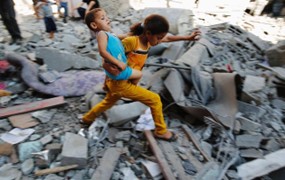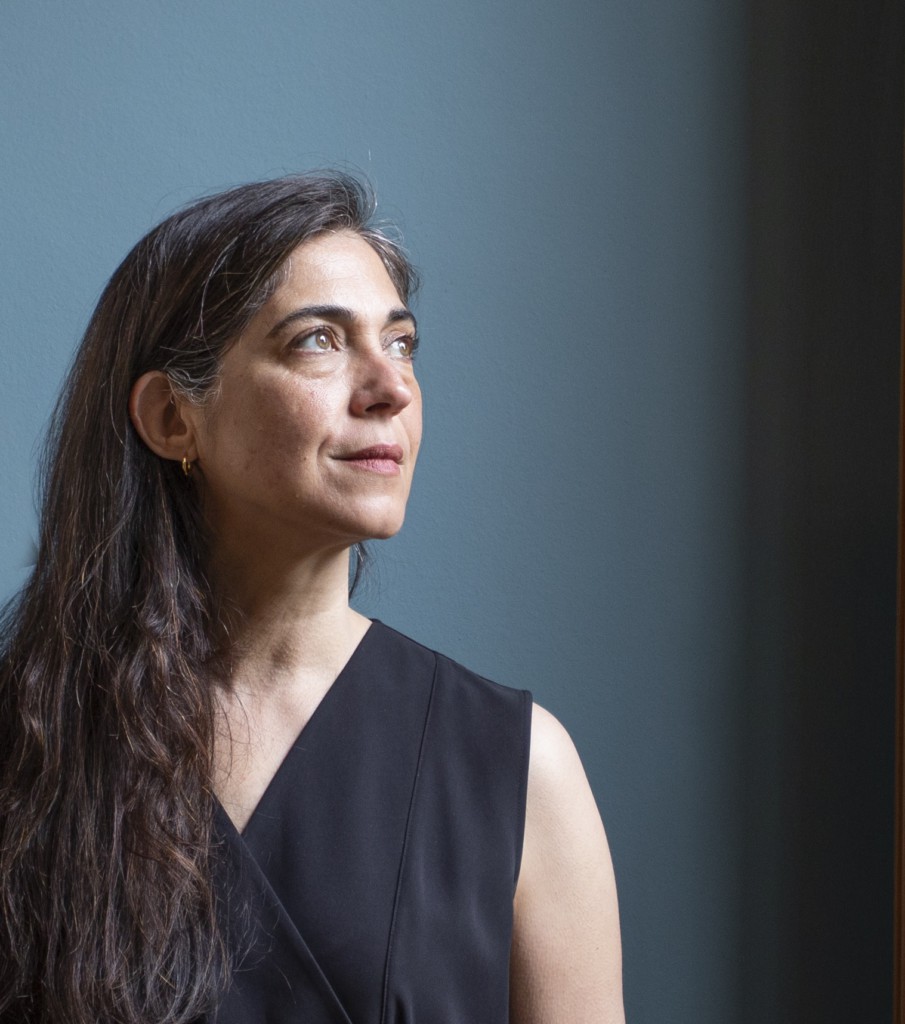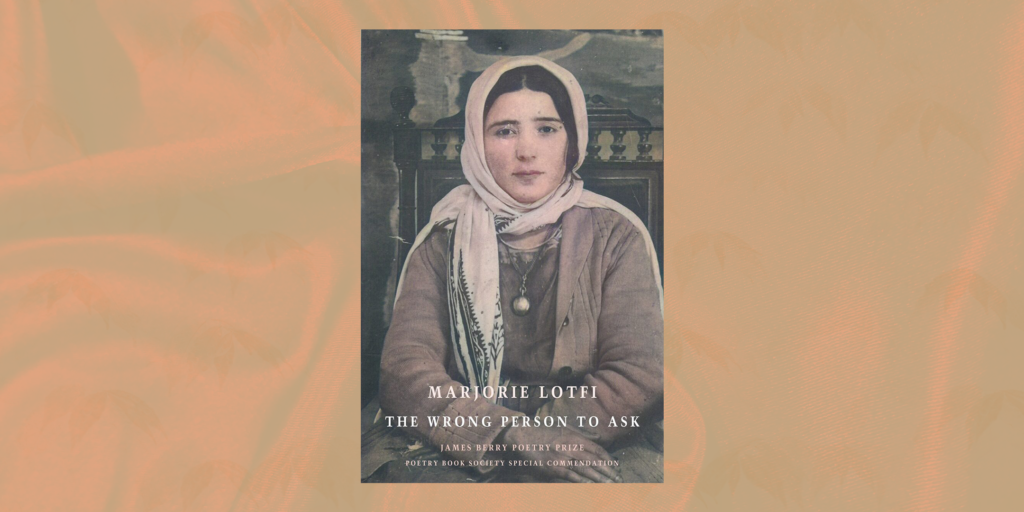Welcome to our Forward Prizes 2024 ’How I Did It’ series. This year we asked poets shortlisted for the Felix Dennis Prize for Best First Collection to write about the inspiration behind one of the poems from their chosen collection. Here’s Marjorie Lotfi on what inspired her to write the poem ‘Picture of Girl and Small Boy’ in The Wrong Person to Ask.
‘Picture of Girl and Small Boy (Burji, Gaza, 2014)’
I would like to tell her not to wear such flimsy shoes,
that rubble contains the whole spectrum of knowable
and unknowable dangers: sheets of metal, ripped
to knife edge, live wires, bloated arms reaching
for light. Her hair, scraped back into a ponytail,
is open to sky; remnants of buildings filter down
one concrete chunk at a time, and the midday bells
of rockets ring out above her. She carries a boy
on her still narrow hips, his legs entwined around
her yellow dungarees. Like a rodeo rider, his left arm
grips her shoulder to steady himself, or her,
while his torso reels back and away; his body
is asking to slow down, to turn back. Instead,
her eyes comb the ground for a next step, fingers
of her free hand curled into a claw, as if
to frighten off what she somehow sees ahead.

I wrote ‘Picture of Girl and Small Boy (Burij, Gaza 2014)’ in response to a photograph of a girl carrying boy on her hips through a refugee camp in Gaza. The image had appeared on the cover of The Times that week; I’d ripped it from the paper, sensing that I wanted to respond to it in poetry. Every poem I write teaches me something, and looking back, I can still see what this poem taught me:
Trust Your Instincts and Take Your Time
I knew that the photograph had stuck with me, but I wasn’t immediately able to understand why. I didn’t try to write the poem on the day I’d seen the image but kept a hold of it and allowed my initial (subconscious) response to develop. By the time I wrote the poem, I knew I wasn’t going to attempt any BIG statement about refugee children, for example, but that simply describing the children in the photograph would be enough.
Look Beyond What Originally Catches Your Interest
In this case, taking a hard look at what surrounds the children in the image – grey rubble, a few household objects decipherable through the dust covering them, people standing at a distance to the subjects of the image – mattered. The young children’s proximity to the other people in the photograph underlines both their vulnerability and our distance from their reality. Also, the image is blurry in parts, suggesting that the children are running across the rubble; I knew I’d want this sense of motion in the poem.
Study the Minor Details
Carefully inspect the image to which you’re responding for small details that could be useful. It could have been sufficient, for example, for me to describe a young girl carrying an even younger boy, but I wanted to anchor her stark youth through a description of her hips (not motherly in any way, though she is carrying in the fashion of a mother). I also studied the little boy, knowing I’d want to describe his response to this journey – how his body is not committing to forward motion. These details were a great opportunity to suggest that children of conflict (as I know well) take on responsibilities larger than their years, and often want to go back to a time where things were ‘normal’. Other tiny and relatable details – yellow dungarees, her hand curled into a claw – speak both to what is happening in the image and also, more broadly, to the life of a child refugee.
Allow Yourself into the Poem
For a while, I couldn’t decide if it was appropriate to write myself and my response into the poem. On the one hand, I have experience of displacement as a child, and in some small way know what it is like to be asked to grow up faster than expected. I also remember hearing rockets go off, and the sound of gunfire on the streets. On the other hand, I’ve never lived in a refugee camp. The fact that my response was that of a mother – what I’d like to say to her if I could – was what allowed me to leave the opening as it had come. My hope was that this opening also asks the reader to engage, to think about what they would say to these refugee children if they had the chance.
Consider Your Title
While it seems a little boring, the title here does the work of establishing the subject and location of the poem, before the reader gets into the body of the story. The entirety of the poem can then be about developing what the reader sees.
Edit, Set It Aside, and Edit Again
This poem started out twice its current length; when I write a first draft, I don’t let the ‘editor voice’ in. The next task, not at the same sitting, is to parse through the words and decide what to keep – usually about half of what I’ve written – identifying the images and ideas I really need. (I don’t want to overwhelm my reader or suggest ‘answers’, nor do I want to leave so little that my reader is left guessing.) For me, getting that balance right is critical to the success of the poem, and it’s probably what I spend the most time on. For this poem, I know that I will have made those harsh edits almost immediately, because it was originally published in a terrific series in the USA called Rattle Poets Respond, which publishes poems responding to news stories of the week. (Submissions are free, and response time is only a few days, so it’s a great weekly challenge to set yourself.) This first publication didn’t stop me from editing the poem further when it came time for including it in my collection. I chose to take out the ‘life-jacket-yellow’ description, seeing that ‘yellow’ did the job of flagging a needed ‘rescue’, and I shortened the ending. The Guardian chose to publish the amended version, paired with a more recent photo of Gaza, which underscored how often our finished pieces of writing move away from their source of inspiration and stand on their own.
BIO
Marjorie Lotfi is the author of The Wrong Person to Ask (Bloodaxe Books, 2023), which is currently shortlisted for the 2024 Felix Dennis Forward Prize for Best First Collection. It was one of the winners of the inaugural James Berry Prize and a Poetry Book Society Special Commendation.
Marjorie’s poetry has been published widely, most recently on London’s Poems on the Underground. She is one of the UNESCO Cities of Literature’s ILX 10 ‘Rising Stars of UK Writing’, a Royal Literary Fund Fellow and a member of Writer’s Mosaic.


Add your Reply
You must be logged in to post a comment.